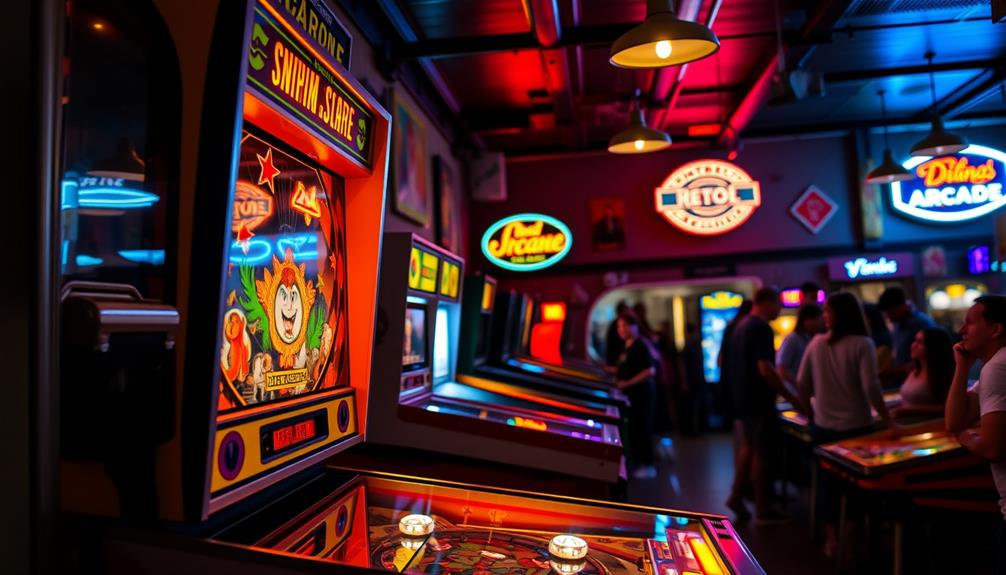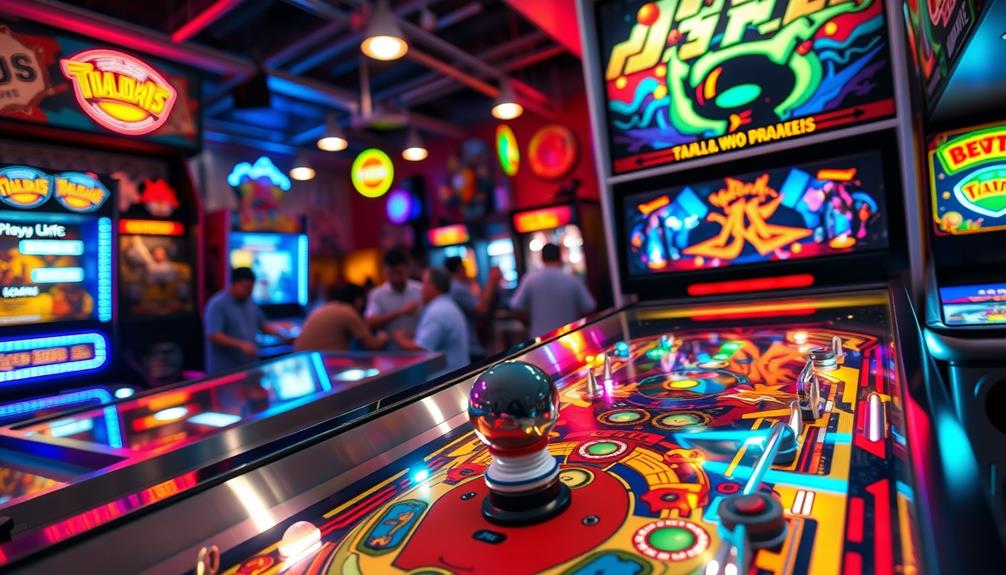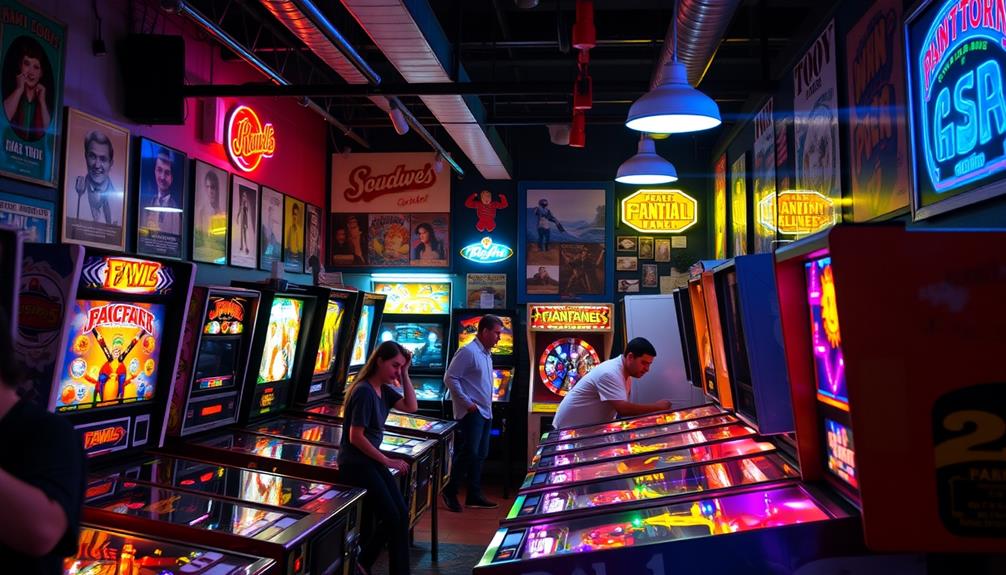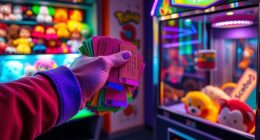Creating a pinball machine involves several important steps that combine creativity and engineering. Initially, designers use CAD software to develop prototypes, which are thoroughly tested for quality and functionality. The construction process incorporates high-quality materials such as plywood and stainless steel to ensure longevity. The assembly line, operated by skilled workers, assembles around 1,000 components over a span of 20-30 hours. Each machine includes detailed wiring and captivating playfield features, like flashing lights and themed designs. Following extensive testing to ensure flawless operation, the machines are packaged for eager players. There is a lot more to explore about the intriguing world of pinball production!
Key Takeaways
- The design and prototyping process for pinball machines takes 12 to 18 months, involving multiple revisions and rigorous testing for quality assurance.
- High-quality materials like plywood, molded plastic, and corrosion-resistant metals are selected to enhance durability and gameplay experience.
- Approximately 1,000 parts are assembled in 20-30 hours, with a combination of automated and hand assembly techniques ensuring efficiency.
- Wiring involves over 750 meters of color-coded wire, with secure connections achieved through soldering and crimping for reliability during gameplay.
- Quality control measures include thorough parts inspection, prototype testing, and computerized diagnostics to ensure functional and durable machines before mass production.
Design and Prototyping Process
Creating a new pinball machine kicks off with a meticulous design and prototyping process that typically spans 12 to 18 months. You start by using CAD software to create a whitewood prototype, refining the playfield layout and design elements through multiple revisions.
This phase is vital for guaranteeing the machine meets high-quality standards and aligns with your creative vision. By employing strategies from igniting creativity, designers can overcome digital distractions and enhance their innovative approaches during this formative stage.
Cost tracking is essential during the design and prototyping process, as budget constraints can greatly influence the materials and design features you choose. Once the final design is completed, you'll assemble 10 to 20 prototypes.
These prototypes undergo rigorous testing, including regular field tests and drop tests, to identify any assembly issues and verify safety before mass production. This thorough testing phase helps assure that each component fits perfectly and that all suppliers meet the required specifications.
Raw Materials Used

When you look at a pinball machine, you mightn't realize the thought that goes into selecting its raw materials. The choice of materials is essential because high-quality content can enhance the overall experience of the game, much like how content relevance and authority are prioritized in holistic SEO.
The playfield is crafted from sturdy plywood, while metal components are made from corrosion-resistant materials like stainless steel. Additionally, special elements are molded from plastic, showcasing the variety of materials that contribute to the machine's functionality and design.
Playfield Material Selection
The playfield material selection for pinball machines plays a fundamental role in balancing durability and cost. Manufacturers mainly choose inexpensive yet sturdy plywood for the playfield, guaranteeing it can withstand the rigors of gameplay without breaking the bank. This material provides the foundation needed for high-quality production while keeping expenses manageable.
A well-planned budget is imperative for manufacturers, as it allows them to allocate resources effectively and avoid overspending on materials while maintaining quality budgeting essentials.
In addition to plywood, special playfield elements often utilize molded plastic, enabling intricate designs that enhance the visual appeal and gameplay experience. This clever use of materials allows for creativity without sacrificing performance.
While you might notice metal components like screws and springs, they're typically crafted from stainless steel or aluminum, reinforcing durability and longevity.
The production process for playfields is largely automated, with high-pressure machines used to precisely incise the boards. This precision is essential for maintaining high-quality standards.
However, cost control measures lead manufacturers to carefully select the cheapest materials that still meet necessary specifications for performance and safety, guaranteeing a reliable product without excessive spending.
Balancing these factors guarantees that pinball machines can deliver engaging gameplay while remaining profitable for manufacturers.
Metal Component Specifications
Durability and reliability are paramount in the metal components of pinball machines, where stainless steel and aluminum are the go-to materials. These metals excel due to their corrosion resistance and strength, ensuring that your machine withstands the test of time. Key metal components, such as screws and springs, play a significant role in the mechanical functions of the game.
In addition, the selection of high-performance materials can enhance the overall efficiency of the machine, similar to how energy-efficient models can reduce heating and cooling costs considerably.
When you think about the structural integrity of a pinball machine, you can see how essential these metal parts really are. While playfield elements may often be made from molded plastic, the metal components provide the necessary support and stability that keeps everything functioning smoothly.
Vendors supplying these parts must adhere to exact specifications, ensuring compatibility with the overall design. This attention to detail is essential for maintaining performance standards.
However, cost control measures can sometimes lead to the selection of cheaper metal materials. Manufacturers will choose different types of metals that still meet the specifications needed for peak performance, balancing quality with budget constraints. In this way, the choice of metal components directly impacts both the gameplay experience and the longevity of the machine.
Special Element Manufacturing
Creating special playfield elements for pinball machines involves carefully selecting raw materials that balance durability and design flexibility. Most of these elements are crafted from molded plastic, which offers the right combination of strength and versatility to meet the creative demands of American pinball.
Additionally, metal components like screws and springs are typically made from stainless steel or aluminum. These materials guarantee strength and corrosion resistance, crucial for the longevity of the machines. The playfield itself is constructed from sturdy plywood, providing a cost-effective and reliable base.
To illustrate the materials involved in manufacturing special playfield elements, here's a quick overview:
| Material Type | Purpose |
|---|---|
| Molded Plastic | Special playfield elements |
| Stainless Steel | Metal components (screws, springs) |
| Aluminum | Lightweight metal components |
| Plywood | Playfield base |
| Various Vendors | Supply parts to exact specs |
Manufacturing Techniques

When you explore the manufacturing techniques behind pinball machines, you'll see how essential prototyping and testing are to the process.
Incorporating advanced technologies can enhance the design and functionality of these machines, similar to how AI technologies improve threat detection in cybersecurity.
The material selection is equally important, ensuring that each component is both durable and cost-effective.
Prototyping and Testing
The journey from concept to a fully functional pinball machine kicks off with prototyping and testing, essential steps that guarantee every component works seamlessly together. Years ago, designers relied on basic methods to prototype, but today they use advanced CAD software to create a whitewood prototype. This initial version undergoes multiple revisions, refining the design to meet specifications.
A methodical approach, similar to that employed in best practices in software quality assurance, is vital in ensuring that the design is systematically tested and improved.
Once the final design is set, manufacturers assemble 10-20 prototypes. Each prototype is tested rigorously, ensuring all parts fit correctly and function as intended. You'll find these tests include regular field testing and drop tests to examine sturdiness and identify assembly issues.
This stage is essential, as it allows for adjustments before mass production begins. Quality control mainly hinges on these prototypes; they serve as the primary check for the overall product.
After initial testing, a small production run of 50-100 games may be created. This step helps finalize the production line setup and make any last tweaks, ensuring that every pinball machine delivers not just thrilling gameplay but also the perfect sound effects that enhance your experience.
Material Selection Process
Material selection plays an essential role in crafting a pinball machine that balances durability and cost-effectiveness. When you're involved in this process, consider several key factors to guarantee your machine meets quality standards without breaking the bank.
The importance of using high-quality materials is similar to the emphasis on natural materials in modern farmhouse decor trends, guaranteeing both functionality and aesthetic appeal in your design.
- Playfield Material: Use inexpensive, sturdy plywood for the playfield. It guarantees durability while keeping costs low.
- Metal Components: Opt for stainless steel or aluminum for screws and springs. These materials enhance strength and resist corrosion, important for longevity.
- Special Elements: Choose molded plastic for intricate playfield designs. It allows for creativity while maintaining structural integrity.
- Cost Control: Always prioritize materials that meet necessary specifications for quality and safety but are also the cheapest option available.
Assembly Line Efficiency
Efficient assembly lines are vital for the successful production of pinball machines, where about 1,000 parts come together to create a single unit. The entire assembly process typically takes 20-30 hours and involves around 1,000 factory workers collaborating on various components.
To guarantee a smooth workflow, the assembly line is highly organized, with a focus on sector performance metrics that can influence production decisions. Small parts require hand assembly, while the production of the playfield is primarily automated, using high-pressure machines to incise boards. This combination of manual and automated techniques helps maintain high levels of efficiency and precision.
Before mass production begins, quality control is emphasized, with individual parts inspected upon arrival. This step is vital for maintaining assembly line efficiency and product standards.
To perfect the assembly process, a small initial run of 50-100 games is produced. This allows for final adjustments and prepares the production line for larger batches.
Wiring and Electronics

Wiring and electronics play an essential role in the functionality of a pinball machine, with over 750 meters of wire meticulously organized by color codes for easy identification. These wires connect various components, ensuring the machine operates smoothly during gameplay.
In addition to the complex wiring, proper maintenance is vital for ensuring longevity and performance, similar to the way air purifier maintenance dos and don'ts can impact air quality. You'll find that each machine employs sophisticated techniques for secure connections.
Here are some significant aspects of wiring and electronics in pinball machines:
- Secure Connections: Wires are connected to circuit boards through soldering and crimping processes, making sure each connection is reliable.
- Durability: The wiring is permanently attached via soldering and fusing, preventing disconnections during intense gameplay, which enhances both durability and performance.
- Functionality Testing: Before final assembly, a testing board is used to check the functionality of every circuit, ensuring everything works correctly.
- Gameplay Mechanics: Each pinball machine may incorporate up to 70 switches, essential for various gameplay mechanics and interactions, providing an engaging experience for players.
With this intricate wiring system, you can enjoy the thrilling and dynamic nature of pinball, knowing that each component is designed for peak performance.
Playfield Preparation

Playfield preparation is an important step in crafting an engaging pinball machine, where attention to detail can greatly enhance the player experience. The playfield's vibrant artwork isn't just for aesthetics; it plays a significant role in gameplay.
You'll notice that foam strips are strategically placed to protect against nail punctures during assembly, ensuring the surface remains intact and visually appealing. In parallel to the care taken in camping gear selection, as seen in important camping gear, meticulous preparation is key to achieving an enjoyable outcome.
As you explore the preparation process, you'll see that nail holes are carefully positioned to act as markers for various targets and features. This precision aids in the accurate installation of components, making sure everything lines up perfectly.
A metal template guides the drilling process, allowing you to install gadgets with pinpoint accuracy, which is essential for smooth operation. Additionally, anchors are installed to secure railings and other components, providing the stability and durability that keep the playfield intact during play.
Each of these steps is significant, as they contribute to both the visual and functional aspects of the pinball machine, ensuring that players enjoy a seamless and exciting gaming experience.
Assembly and Installation

As you immerse yourself in the assembly and installation phase of a pinball machine, you'll find that every component plays a critical role in shaping the overall gameplay experience.
During this stage, you'll install a total of 115 flashing lights, which create vibrant visual effects that enhance the excitement of the game.
Wiring is permanently attached via soldering and fusing, ensuring secure and reliable connections throughout the machine.
You'll also incorporate a spring-powered plunger, essential for launching the ball, which is a core mechanic of pinball gameplay.
Moreover, thematic elements come to life when you add toy characters and ramps, further enriching the player's experience on the playfield.
To protect everything, the playfield is secured with a shatterproof window, locked down with a metal bar, ensuring durability.
Key components in this phase include:
- Installation of 115 flashing lights
- Permanent wiring through soldering and fusing
- Inclusion of a spring-powered plunger
- Addition of toy characters and ramps
Quality Control Measures

When it comes to quality control, you'll want to focus on thorough parts inspection right from the start.
Prototypes play an essential role in catching any assembly issues before mass production kicks off. By evaluating these early models, you can make necessary adjustments and guarantee a smoother production line.
Prototype Testing Importance
Prototype testing plays an essential role in guaranteeing pinball machines meet quality standards before mass production kicks off.
You'll find that prototypes serve as the primary quality check, confirming that all components fit and function correctly. During this critical phase, several key aspects are addressed:
- Assembly Issues: Testing identifies potential glitches, allowing modifications before larger batch production.
- Sturdiness and Safety: Regular field testing and drop tests assess the machine's durability and player safety, essential for quality assurance.
- Gameplay Feedback: Insights from prototype testing inform final design tweaks, enhancing the overall gameplay experience.
- Initial Production Run: After evaluations, a small run of 50-100 games is produced to make final adjustments and guarantee the production line is primed for larger batches.
Parts Inspection Protocols
Inspecting parts upon arrival is vital to confirming that every component of a pinball machine meets the exact specifications set by manufacturers. This thorough quality control measure begins with checking individual parts against predetermined standards.
Here's a brief overview of the inspection process:
| Inspection Stage | Purpose | Outcome |
|---|---|---|
| Arrival Inspection | Verify that delivered parts match specifications | Identifies defective components |
| Prototype Testing | Assess overall functionality | Determines necessary modifications |
| Small Production Run | Test assembly line readiness | Allows for final adjustments |
| Feedback Evaluation | Gather data from tests | Improves production decisions |
Prototypes serve as a primary quality check, allowing for extensive testing before mass production begins. During this phase, any assembly glitches are identified, leading to essential modifications in the manufacturing process. After inspection, a small run of 50-100 games is produced to confirm production line readiness, enabling final adjustments based on initial tests. Feedback from these evaluations enhances quality control, guaranteeing the final product meets design standards and provides an exceptional gaming experience.
Testing Procedures

Before pinball machines hit the production line, they go through a series of rigorous testing procedures to iron out any potential issues. These tests guarantee that every component functions as intended and that the overall game can withstand regular use.
Here's a breakdown of the main testing strategies:
- Prototype Testing: One prototype undergoes field testing to check gameplay, while another faces a drop test to evaluate its sturdiness.
- Quality Control: Each part is inspected upon arrival to verify it meets specifications before it's integrated into the machine.
- Inaugural Run: This initial run tests all targets and mechanisms within the game, confirming they operate reliably and efficiently.
- Computerized Diagnostics: A sophisticated system is employed to identify any malfunctions during testing, allowing for quick resolutions to issues.
Through these thorough testing procedures, manufacturers guarantee that every pinball machine is ready for the demands of enthusiastic players.
Finalization Steps

Completing the testing phase, manufacturers focus on finalization steps to assure that each pinball machine meets high standards of quality and performance. During the inaugural run, all targets and mechanisms undergo rigorous testing to ascertain everything functions perfectly before mass production begins.
You'll notice that each game can feature up to 70 switches, and a computerized system helps diagnose any malfunctions that arise during these tests.
Once testing wraps up, safety becomes a priority. A shatterproof window is installed over the playfield, enhancing durability and protecting players.
After all adjustments based on initial feedback are made, the machine is locked down with a metal bar. This step is vital as it prevents any damage during transport and guarantees the machine arrives in pristine condition.
Manufacturers also utilize feedback from the testing phase to inform final adjustments to the design and assembly processes. This continuous loop of improvement helps enhance the overall gaming experience.
With everything in place, your pinball machine is ready to be packaged and shipped, bringing the excitement of the arcade directly to you.
Marketing and Promotion

With the finalization steps complete, manufacturers turn their attention to marketing and promotion, showcasing their pinball machines to the gaming community. Pinball Adventures, for example, engages directly with enthusiasts through various channels, guaranteeing their unique and high-quality machines capture attention.
Here are four key strategies they use:
- Trade Shows and Public Displays: These events allow you to see the machines in action, offering firsthand experience of innovative gameplay.
- Website: Their site, pinballadventures.com, keeps you updated on new releases and product offerings, making it easy to stay in the loop.
- Social Media: By leveraging platforms like Instagram, they foster community engagement and encourage feedback, creating a dialogue with gamers.
- Prototypes: These serve a dual purpose; they're essential for testing and act as marketing tools to showcase new designs and features.
Through these strategies, Pinball Adventures emphasizes innovative gameplay and nostalgia, evoking the joy of early gaming experiences.
Frequently Asked Questions
How Was the Pinball Machine Made?
To create a pinball machine, you start with a prototype, refine the design, then assemble around 1,000 parts, including wiring and lights, ensuring everything functions perfectly through rigorous quality checks before production.
What Materials Are Pinball Machines Made Of?
Pinball machines are made from durable plywood for the playfield, stainless steel or aluminum for metal parts, molded plastic for special elements, and colorful silk-screen printed artwork, ensuring both functionality and vibrant aesthetics. Materials used in pinball machines are carefully chosen for their strength and durability to withstand the wear and tear of constant play. The plywood is often coated with a high-pressure laminate to protect the surface from damage. Additionally, the metal parts are precisely engineered to provide smooth and reliable ball movement, while the plastic elements are designed to add excitement and challenge to the gameplay. Overall, the materials used in pinball machines are selected with the goal of creating a long-lasting and visually appealing game experience.
Why Was Pinball Illegal?
Pinball's prohibition primarily stemmed from perceived problems. People feared it fostered gambling, encouraged cheating, and threatened youth. Ultimately, shifting opinions and a pivotal court case helped lift these longstanding legal limitations on pinball machines.
What Is the Ball in a Pinball Machine Made Of?
The ball in a pinball machine's made of solid steel, ensuring durability and consistent weight. It measures about 1.125 inches in diameter and weighs around 0.20 pounds, providing that exciting gameplay you love.
Conclusion
In the enchanting world of pinball machines, every step from design to final touches is a labor of love. You've seen how creativity and craftsmanship blend seamlessly, bringing vibrant playfields to life. Each machine isn't just assembled; it's carefully curated, ensuring it delights players for years to come. As you marvel at these enthralling creations, remember they're not just games but intricate stories waiting to be played. So go ahead, let the magic of pinball whisk you away! Even in today’s digital age, the charm of these mechanical marvels endures, captivating both seasoned players and new enthusiasts alike. For those wondering, are pinball machines still manufactured, the answer is a resounding yes—crafted with the same passion and attention to detail that has defined them for decades. These modern machines often fuse cutting-edge technology with classic design, ensuring the legacy of pinball thrives for generations to come.









